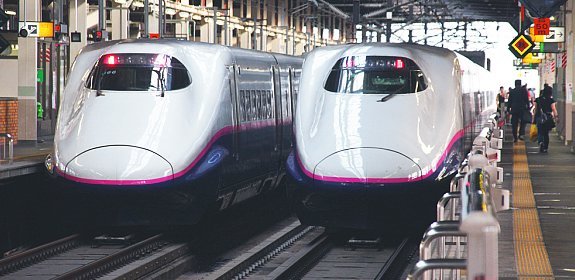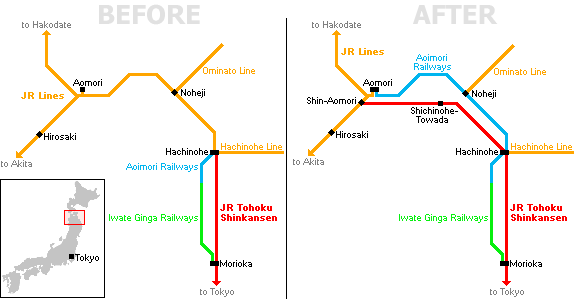Japan Travel News - Tohoku Shinkansen Extension

On December 4, 2010, the Tohoku Shinkansen was extended by 80 kilometers from its current terminus at Hachinohe to Shin-Aomori Station just outside of central Aomori City. Thanks to the extension, the average travel duration from Tokyo was reduced as follows:
- by around 15 minutes to reach Aomori Station (down to 4 hours)
- by around 25 minutes to reach Hirosaki (down to 4 hours 30 minutes)
- by around 15 minutes to reach Hakodate (down to 6 hours)
- by around 20 minutes to reach Sapporo (down to 9 hours 45 minutes)
From March 5, 2011, travel times will be further reduced by around 20 minutes with the introduction of the "Hayabusa" trains with new, faster train sets than the current "Hayate" trains. The new train sets will allow for top speeds of 300 km/h initially and of 320 km/h by spring 2013.
The Japan Rail Pass and JR East Pass are valid on both Hayate and Hayabusa trains.
Shin-Aomori Station
Shin-Aomori Station serves as the new terminal station of the Tohoku Shinkansen. The station is located outside of the city center of Aomori, a 6-7 minute train ride from the centrally located Aomori Station. The two stations are connected by relatively frequently operating local and limited express trains, and a special rule allows travelers to use limited express trains without a limited express supplement when riding between just the two stations in the unreserved section of the train.
Shichinohe-Towada Station
Shichinohe-Towada Station is the only station between Hachinohe and Shin-Aomori Stations along the newly extended section. The new station is served by roughly two out of three passing trains, and has become the closest shinkansen station to the tourist destinations of Lake Towada and the Shimokita Peninsula.

Changes in Limited Express Train Services
As a result of the shinkansen extension, the "Hakucho" and "Super Hakucho" limited express trains, which used to run between Hachinohe and Hakodate, were re-routed to now run between Shin-Aomori, Aomori and Hakodate. The "Tsugaru" limited express, which used to run between Hachinohe and Hirosaki, is now running between Aomori, Shin-Aomori, Hirosaki and Akita.
Changes for the Japan Rail Pass and Seishun 18 Kippu
With the completion of the Tohoku Shinkansen, JR East transferred the non-shinkansen railway tracks between Hachinohe and Aomori to Aoimori Railways, a non-JR company. This results in the unique situation where the JR Ominato Line (from Noheji to the Shimokita Peninsula) is now completely isolated from the rest of the JR network and the JR Hachinohe Line remains connected to the JR network only through a shinkansen line.
In order to keep these two lines accessible to holders of the Japan Rail Pass and Seishun 18 Kippu, a special rule was introduced, allowing pass holders to ride the Aoimori Railway "for free" if they only get on or off at Aomori, Noheji or Hachinohe Stations. If getting on or off at any other station along the Aoimori Railway, however, the regular fare has to be paid.
Furthermore, the transfer of railway tracks to a non-JR company also caused the night trains between Tokyo and Sapporo to use a longer non-JR section than before. Consequently, the supplement to be paid by Japan Rail Pass holders increased from 19,000 yen to 21,500 yen for a regular compartment on the Cassiopeia and from 12,000 yen to 14,500 yen for a regular berth on the Hokutosei (approximate amounts per person one way).
Future Plans
The further extension of the northern shinkansen from Aomori to Hakodate on the island of Hokkaido is currently under construction. This first section of the Hokkaido Shinkansen is scheduled to open by the year 2016. An extension to Sapporo is currently in the planning phase.
Meanwhile in the south, the completion of the Kyushu Shinkansen will take place on March 12, 2011. We will publish a separate news story on the completion of the Kyushu Shinkansen in mid December.